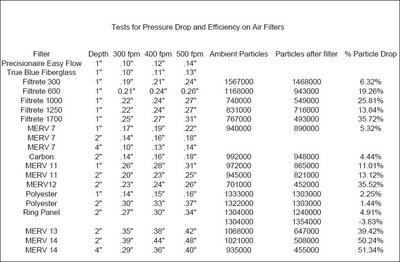
We test 20 filters for pressure drop and efficiency.
It is often very difficult to compare pressure drop for HVAC air filters. Even though filter tests are standardized it is not unusual for the same type of filter to be tested in two different laboratories with two different results. In addition, filter tests are run at different speeds which has a significant effect on pressure drop numbers. In addition, marketing literature is not consistent and one can seldom compare published data from product to product. Consequently, there is a great deal of confusion in this area.
Furthermore, there are a number of myths in the HVAC industry regarding air filters. One of the most enduring is that “throwaway” one month filters are the only type of filter that can be used in some HVAC systems. The jist of the myth is that these filters are the only ones that have a low enough resistance to allow sufficient airflow for the system to operate adequately.
To build some good comparative data we tested 20 different air filters of various types, thicknesses and efficiencies. Our test duct is 8 feet long, two feet wide and two feet high. It holds 24″X24″ filters with a depth of up to 20″. The test duct fans can operate up to a speed of 750 fpm. A magnahelic gauge is installed that measures the pressure drop in “inches of water” from before the filter to after the filter.
Twenty filters were obtained for the tests. Ten were purchased at hardware and home improvement stores. The balance were various “commercial” filters from different manufacturers.
Each filter was tested at 300 fpm, 400 fpm and 500 fpm and the pressure drops were recorded. In addition, a laser particle counter that counts particles of 0.3 microns and larger was used to determine the ambient particle count and the particle count at the air exiting side of the test duct for each filter.
The results of the tests are presented in the above table. Filters purchased in stores are listed by their trade name. Commercial filters are listed by the type of filter or the MERV of the filter.